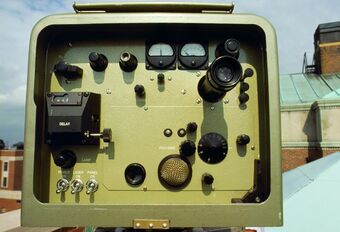Engineering:Geodimeter
The Geodimeter (acronym of geodetic distance meter) was the first optical electronic distance meter surveying instrument.[1][2] It was originally developed for measuring the speed of light.[3][4] It was invented in 1947 by Erik Osten Bergstrand (sv) and commercialized in 1953 by the AGA (Aktiebolaget Gasaccumulator) company of Sweden.[5][6] It was used in the Transcontinental Traverse.
The Geodimeter business was acquired by SpectraPrecision which was acquired by Trimble Inc.[citation needed]
Electronic mechanism
The mechanism uses a Kerr cell in an optical train that chops a collimated beam of light under the control of a precision electronic oscillator in the megahertz range.[7] It is similar in principle to the mechanical chopper in Fizeau's measurement of the speed of light in air that used a toothed wheel.[8]
See also
References
- ↑ Rüeger 2012, p. 15.
- ↑ Bergstrand 1952.
- ↑ Froome & Essen 1969.
- ↑ Bergstrand 1950.
- ↑ Laurila 1960, p. 194.
- ↑ "AGA Geodimeter". 2014-10-03. http://www.aga-museum.nl/page/aga-geodimeter-nasm-2a.
- ↑ Poling 1959.
- ↑ "EDM (Geodimeter Model 2A)", Database: Physical Sciences Collection - Surveying and Geodesy (Smithsonian Institution), 4 August 2015, catalog number 1998.3094.01, https://amhistory.si.edu/surveying/object.cfm?recordnumber=748815, retrieved 2018-05-02
Sources
- Bergstrand, Erik (1950). "Velocity of Light". Nature (Springer Science and Business Media LLC) 165 (4193): 405. doi:10.1038/165405a0. ISSN 0028-0836. Bibcode: 1950Natur.165..405B.
- Bergstrand, Erik (1952). "Distance measuring by means of modulated light". Bulletin Géodésique 24 (1): 243–249. doi:10.1007/BF02526937. ISSN 0007-4632. Bibcode: 1952BGeod..26..243B.
- Poling, Austin C. (1959). Geodimeter Manual. U.S. Coast and Geodetic Survey. Publication 62-2. https://books.google.com/books?id=GdMGb4zyvTsC.
- Laurila, Simo (1960), "Geodimeter", Electronic Surveying and Mapping: Part 1, Fundamentals of Electronic Surveying, Institute of Geodesy, Photogrammetry and Cartography, The Ohio State University, pp. 194–203, OCLC 58011617, https://hdl.handle.net/2027/uiug.30112007333120, retrieved May 6, 2021
- Froome, K.D.; Essen, L. (1969). The Velocity of Light and Radio Waves. Academic Press. ISBN 9780122428500. https://books.google.com/books?id=a7fvAAAAMAAJ. Retrieved 2020-09-24.
- Rüeger, J.M. (2012). Electronic Distance Measurement: An Introduction. Springer Berlin Heidelberg. p. 15. ISBN 978-3-642-80233-1. https://books.google.com/books?id=QNytBAAAQBAJ&pg=PT15. Retrieved 2020-09-24.
Further reading
- Poling, Austin C. (April 1958), "The Geodimeter and Tellurometer", Journal of the Surveying and Mapping Division (American Society of Civil Engineers) 84 (1), doi:10.1061/JSUEAX.0000024
- Smith, J.R. (1998), The History of Geodimeter, Sweden: Spectra Precision, 07-98 Publ. No. 571 710 000, http://www.geotronics.it/public/geodimeter_story.pdf
External links
- AGA Geodimeter Model 6 (Going the Distance: A Photo Collection Illustrating the History of Distance Measurement Tools at the National Geodetic Survey)
 |


